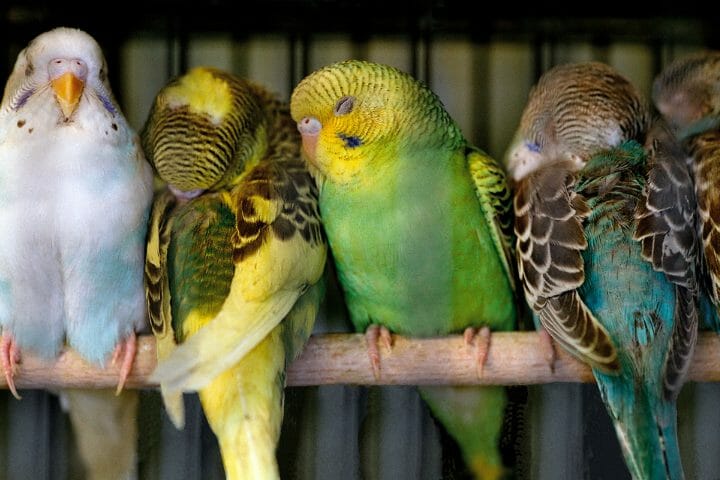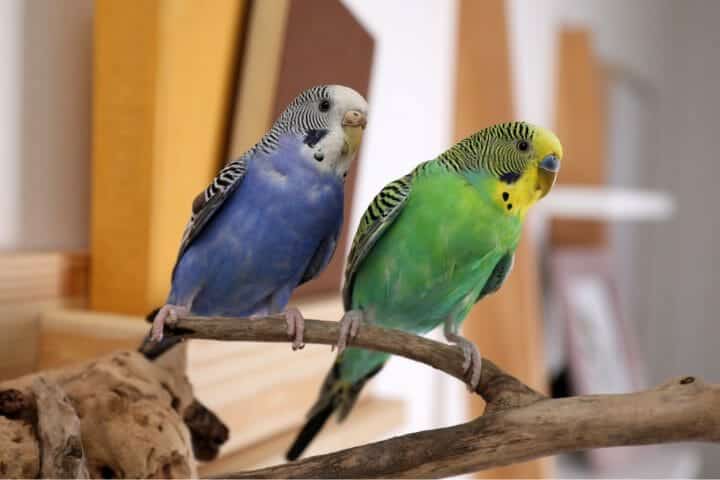Budgies typically sleep perched on a branch or in their cage. They rest upright, fluffing up their feathers to keep warm.
Budgies, or parakeets, are small, vibrant birds popular as pets across the globe. Known for their sociable nature, these creatures follow a diurnal sleep pattern, meaning they’re active during the day and rest at night. Just like humans, a good night’s rest is essential for their health and well-being.
How Do Budgies Sleep? To create a comfortable sleep environment, they seek safety in height, choosing to perch securely to avoid predators. It’s also common for them to tuck their heads beneath their wing feathers while sleeping, which serves as both warmth and protection. Understanding their sleep habits can help pet owners ensure their feathery friends maintain a healthy lifestyle and strong bond with their human families.

Credit: earthlife.net
The Sleeping Habits Of Budgies
Have you ever watched a budgie and wondered, how do these vibrant birds sleep? Budgies have unique sleeping routines that fascinate bird lovers. Let’s explore the world of budgies at night and understand their sleeping habits.
Natural Sleep Patterns
Budgies need good sleep just like us. In the wild, these birds follow the sun’s cycle, so their sleep patterns are easy to predict.
- Sleep when it’s dark
- Wake up at sunrise
- 10 to 12 hours of sleep every night
Budgies in a home can still keep these patterns if conditions are right. Keeping a consistent light schedule helps them stay healthy and happy.
Environmental Influences On Sleep
A budgie’s sleep can be affected by what’s around them. Quiet, dark, and comfy spots make for the best sleep.
| Factor | Impact on Sleep |
|---|---|
| Light | Too much keeps them awake |
| Noise | Loud sounds disturb sleep |
| Temperature | Extreme cold or heat can be troublesome |
Give your budgie a consistent sleeping environment. This includes a cage cover at night to mimic darkness and peace. Ensure the room is kept at a comfortable temperature so your little friend can snuggle up and snooze worry-free.

Credit: earthlife.net
Anatomy Of A Budgie’s Sleep
Like other creatures, budgies require rest for health and well-being.
Understanding the anatomy of a budgie’s sleep reveals fascinating insights into their behavior.
Let’s explore the phases and physical changes they undergo during sleep.
Sleep Cycle Phases
Budgies experience different sleep cycle phases quite similar to humans.
These phases repeat several times each night.
- Light Sleep: They can easily wake up during this stage.
- Deep Sleep: Their body recovers and grows during this phase.
- REM Sleep: This is when budgies may dream, and it’s vital for brain health.
Physical Changes During Sleep
While snoozing, a budgie’s physical appearance changes.
| Change | Description |
|---|---|
| Posture | They often rest on one leg, with the other tucked into their feathers. |
| Eyes | Eyes close, with their nictitating membrane protecting it and keeping it moist. |
| Feathers | Feathers puff up, which helps in maintaining warmth. |
| Head | They might tuck their head back amongst their shoulder feathers. |
| Breathing | Breathing rates slow down as their body enters a relaxed state. |
Creating A Sleep-friendly Environment
Creating a Sleep-Friendly Environment is essential for your budgie’s health and happiness. In the wild, budgies have specific sleeping habits. In your home, it’s up to you to mimic these conditions. A restful night for your budgie means a quieter and happier pet during the day.
Ideal Cage Placement
The perfect spot for a budgie’s cage can make all the difference in sleep quality. Consider these key points:
- Keep the cage at eye level, so your budgie feels secure.
- Avoid high-traffic areas to minimize disruptions.
- Stay away from windows that can let in light and cause temperature changes.
- Choose a calm corner that is consistent and peaceful.
Reducing Noise And Light
Just like us, budgies need darkness and quiet to sleep well:
- Avoid loud TVs or speakers near the cage at night.
- Use thick curtains or move the cage to a dark room.
- Cover the cage with a breathable cloth to block light and muffle sound.
- Ensure that the cloth doesn’t completely obstruct airflow.
Common Sleeping Positions
Budgies, charming and lively birds, have unique ways of sleeping. Observing their various sleeping positions reveals much about their comfort and health. Let’s delve into how these adorable feathered friends catch their Z’s.
One-legged Roost
Budgies often sleep on one leg, a behavior known as the one-legged roost. This intriguing stance helps them conserve body heat and rest their muscles. When your budgie perches on a single leg, it’s a sign of trust and security, as they wouldn’t adopt such a vulnerable position if they felt threatened.
Head-tucked-in Feathers
In the head-tucked-in position, budgies draw their heads back and nestle them into their back feathers. This cozy posture keeps their beaks warm during the cool night.
By understanding these common sleeping positions, you gain insight into your budgie’s sleep quality and comfort. A happy budgie will shift between these positions effortlessly throughout the night.
The Role Of Darkness In Budgie Sleep
Budgies need darkness to sleep well, just like we do. A dark environment tells their little bodies it’s bedtime. This darkness helps budgies get enough rest. It’s essential for their health and mood.
Light Cycles And Melatonin Production
Light affects how budgies sleep. Their brains release a sleep hormone called melatonin in the dark. This hormone helps them know it’s time to rest. Here’s what happens:
- The sun sets, and the light fades.
- Darkness triggers the pineal gland in their brain.
- This gland makes melatonin.
- Melatonin makes budgies feel sleepy.
In the wild, natural light would control this cycle. But at home, we need to help our budgie friends.
Keeping a steady light and dark schedule is key. Their little bodies rely on this cycle.
Using Cage Covers At Night
When indoors, your budgie might not get the darkness it needs. Lights from TVs or lamps can confuse them. This is where cage covers help.
These covers block out light and help your budgie understand it’s sleep time.
Using a cover is simple:
- Choose a breathable cover.
- Place it over the cage at the same time each night.
- Take it off each morning to simulate sunrise.
Be consistent with the cover use. It helps maintain your budgie’s sleep cycle.
Napping Vs. Nighttime Sleep
Understanding how budgies sleep reveals fascinating aspects of their behavior. Budgies sleep differently during the night than they do when napping throughout the day. Learning the distinction is crucial for their well-being.
Daytime Rest Periods
Budgies are active and social birds, but they need daytime rest to stay healthy. Short naps help them recharge, especially after periods of play or social interaction. These naps are usually quick, lasting only a few minutes.
- Daytime naps are often taken while perching.
- Budgies may tuck their head under their wing for warmth.
- One leg may be lifted to conserve energy.
Distinguishing Between Napping And Distress
It’s essential to differentiate a budgie’s normal nap from signs of distress. A healthy nap involves the budgie being calm and relaxed, while distress can look quite different.
| Napping Behavior | Signs of Distress |
|---|---|
| Quiet and still | Excessive chirping or moving |
| Head tucked smoothly | Head bobbing or shaking |
| Feathers smooth | Feathers fluffed up persistently |
Observe these behaviors to ensure your budgie is just napping and not experiencing discomfort or illness.
Sleep Disorders In Budgies
Just like humans, budgies can experience sleep disorders. These conditions can affect their health and mood. Understanding the signs and knowing when to seek veterinary care is crucial for the well-being of these small, vibrant birds.
Signs Of Sleep Deprivation In Budgies
Several indicators suggest a budgie may not be getting enough sleep:
- Irritability: A normally friendly bird may become snappy or resistant to interaction.
- Feather Picking: Frustration from lack of sleep can lead to self-harm such as feather picking.
- Appetite Changes: Your budgie might eat less or more than usual.
- Lethargy: The bird may show less interest in activities and appear tired.
- Disrupted Sleep Patterns: Waking up frequently or unusual sleeping positions could be signs.
When To See A Veterinarian
If your budgie shows any of the following, a vet visit is necessary:
| Behavior | Action Needed |
|---|---|
| Continuous Sleep Issues | Seek immediate vet assistance. |
| Persistent Lethargy | Arrange for health evaluation. |
| Excessive Feather Picking | Discuss stress and sleep with the vet. |
| Changes in Vocalization | Could be a sign of distress; consult the vet. |
| Lack of Appetite | Address potential underlying issues. |

Credit: www.quora.com
Enhancing Sleep Quality
Budgies need quality sleep to stay happy and healthy. Like us, their sleep is affected by diet, exercise, and environment. Let’s explore how you can improve sleep for your feathery friend.
Diet’s Impact On Sleep
The right food can make all the difference. Here are key nutrition tips:
- Fresh fruits and vegetables: Offer these daily.
- Balanced seeds mix: Use as a base diet.
- Low-fat pellets: Include for comprehensive nourishment.
Avoid sugary and caffeinated foods. They disturb sleep.
Exercise And Mental Stimulation
Exercise burns energy, making rest easier. Few tips:
- Fly time outside the cage.
- Interactive games to chase and fetch.
- Perches and ladders for climbing.
Stimulation tires the mind. Puzzles and toys help.
With these steps, your budgie will sleep soundly, ensuring a joyful mood and a strong immune system.
Conclusion
Understanding budgie sleeping habits is key to ensuring their well-being. Short nights can disturb their rest, so providing a dark, tranquil environment is essential. Keeping their sleep pattern consistent aids their health. Remember, a well-rested budgie is a happy, chatty companion.
Let’s prioritize their sleep for their happiness and ours.
Ryan Everhart is a passionate bird enthusiast and blogger, primarily writing on his website, Avian Whispers. His journey into the world of bird blogging began with a deep interest in parrots, a species that captivated his attention for their intelligence and social behavior. Over time, his content expanded to cover a broader range of bird species, offering insights into bird behavior, care, habitats, and conservation.
Ryan is dedicated to educating his audience, which includes both new bird owners and seasoned enthusiasts. His writing is filled with personal experiences, expert knowledge, and practical advice on bird care. Through Avian Whispers, he aims to foster a deeper appreciation for birds, emphasizing their role in nature and the joys of having them as pets.
Starting with articles focused on parrots, Ryan’s work now encompasses a diverse range of topics such as feeding, training, habitat enrichment, and bird health. His love for birds extends beyond parrots, diving into various avian species. His informative and heartfelt writing reflects his commitment to the well-being of birds and the desire to help others connect with these creatures.
As a growing voice in the bird blogging community, Ryan strives to provide a platform where bird lovers can learn, share experiences, and connect over a shared passion for avian life. His blogs are not only educational but also serve as a reminder of the importance of protecting and nurturing the bond between humans and birds.




